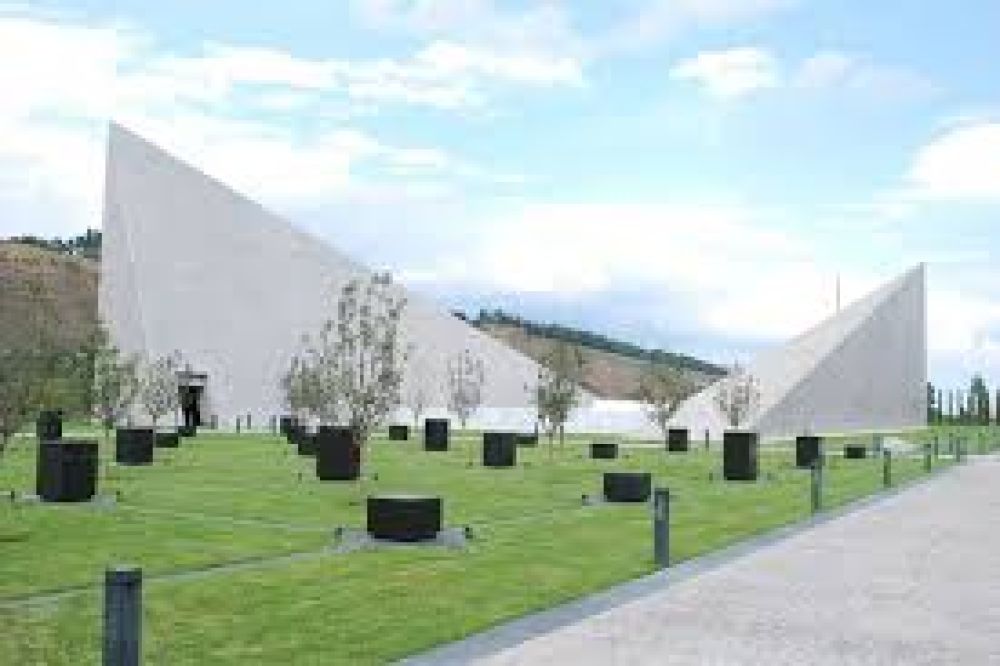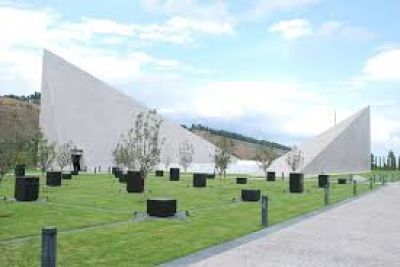

Embark on a historical journey as you visit the Quba Genocide Memorial Complex's museum, a tribute to the victims of the Quba Genocide. Spanning across several themed rooms, the exhibition comprehensively unravels the events leading up to, during, and following the atrocities committed against the local population. Expertly curated artifacts, including photographs, personal items, and documents, provide a poignant narrative of the resiliency and suffering of the Azerbaijani people. Well-informed guides are available to answer questions, ensuring an educational and contemplative experience. Reflect on the past as you navigate through the carefully designed spaces that honour memory and advocate for peace and understanding among nations.
The Memorial Hall within the Quba Genocide Memorial Complex serves as the heart of remembrance for the victims of the tragic events. Visitors are encouraged to spend time in quiet contemplation, surrounded by the names of the innocent lives lost. Walls lined with poignant inscriptions and emotive sculptures set the tone for deep reflection. Moving through the hall, one can sense the solemn commitment to never forget the human cost of conflict. The space is designed to evoke empathy and a deeper understanding of the historical significance of the genocide, ensuring that the memories of those affected are eternally preserved in the collective consciousness of future generations.
The Quba Genocide Memorial Complex offers educational workshops aimed at school groups and other visitors interested in gaining a deeper understanding of the genocide. These workshops are led by educators specializing in historical events and their present-day implications. Participants will engage with interactive presentations, discussions, and activities that facilitate learning about the importance of tolerance, human rights, and peace-building. The workshops are designed to foster critical thinking and to promote the values of unity and reconciliation, drawing lessons from the tragic events commemorated at the complex.
The architectural significance of the Quba Genocide Memorial Complex is undeniable, with its modern design that respects traditional elements while conveying a powerful message through its structure. Visitors can indulge in a tour focusing on the architectural choices that make this complex a memorable landmark. The tour unpacks the symbolism inherent in the design, such as the use of materials, the play of light and shadow, and the orientation of buildings, all of which harmonize to underscore the themes of memory and resilience. Architecture aficionados and history enthusiasts alike will appreciate the careful consideration given to creating a space that is both aesthetically striking and emotionally evocative.
The Quba Genocide Memorial Complex provides visitors with the opportunity to watch various documentaries that detail the historical events surrounding the Quba Genocide. These screenings offer a visual representation of history, bringing to life the stories and experiences of those who witnessed the events. The documentaries often include interviews with historians, survivors, and experts in the field, providing an in-depth and multifaceted view of the genocide. Screenings are held in a purpose-built theater within the complex, allowing for a comfortable viewing experience that encourages learning and reflection on the past.
Take a solemn walk around the grounds of the Quba Genocide Memorial Complex with a knowledgeable guide who will point out significant landmarks and provide a narrative that ties the place to its tragic past. This outdoor activity allows visitors to connect with the landscape that bore witness to history, with various memorials and installations dotting the complex, each telling a part of the story. The guided walks offer a unique perspective on the events and the geography, explaining how the local environment played a role during the genocide and its aftermath. It's a moment to connect physically and emotionally with a poignant chapter in Azerbaijani history.
The Quba Genocide Memorial Complex frequently hosts art exhibitions that feature works related to the themes of memory, loss, and hope. These exhibitions showcase the talents of local and international artists, whose works offer interpretations and reflections on the impact of the genocide. Visitors can browse through paintings, sculptures, and installations that express the complex emotions and narratives connected to the historical events. The art serves as a bridge between the past and the present, inviting onlookers into a dialogue with history and its lasting influence on culture and identity.
On significant dates related to the Quba Genocide, the Memorial Complex hosts remembrance ceremonies that are open to the public. These solemn events often include laying wreaths, speeches by dignitaries and community leaders, and moments of silence. Attendees have the opportunity to partake in collective mourning and honor the victims of the genocide. The ceremonies are designed to foster a sense of unity and shared history, as participants come together to remember and to commit to a future of peace.
The Literature Corner within the Quba Genocide Memorial Complex offers a quiet space for visitors to read and learn about the historical events through a collection of books, memoirs, and research publications. This resource center allows individuals to delve deeper into the subject at their own pace, encouraging self-guided education and reflection. The corner is often updated with new works, ensuring that the most recent scholarship and literature on the Quba Genocide and related topics are accessible to all who are interested in expanding their knowledge.
Cutting-edge interactive multimedia displays within the complex present the history of the Quba Genocide in an engaging and accessible format. These technological exhibits allow visitors to explore archival footage, audio recordings, and digital timelines at their own pace. Touchscreen interfaces enable users to interact with the content, learning about the events through immersive experiences designed to facilitate understanding and empathy. The displays cater to a range of learning styles and are suitable for all ages, making them an essential part of the educational offering of the complex.
